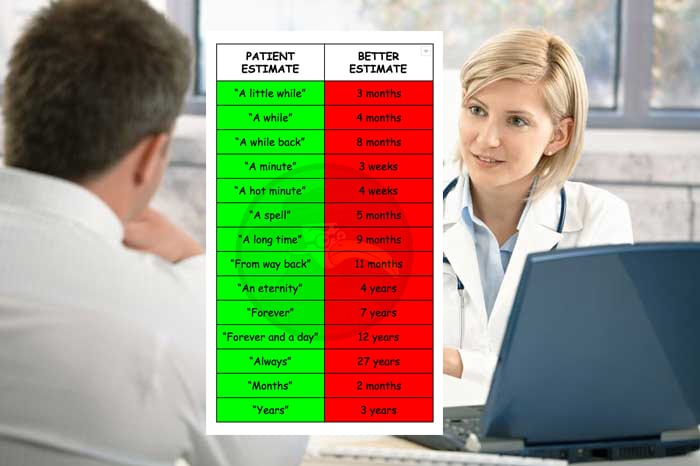ST. LOUIS, MO – It turns out, when a patient’s symptoms have been present for “a while,” they began about 4.2 months ago.
 So say researchers who painstakingly correlated 12,080 chief complaints with tangential, exhaustive histories. Now, ambiguous time descriptors long-favored by patients will be linked to median durations with actual utility.
So say researchers who painstakingly correlated 12,080 chief complaints with tangential, exhaustive histories. Now, ambiguous time descriptors long-favored by patients will be linked to median durations with actual utility.
The landmark study in Monthly Medicine found the length of time for symptoms lasting “a while” was slightly longer than “a little while” (3.4 months), but much shorter than “a while back” (8.3 months). Figure 4 below compares patient estimates to better estimates.
For physicians, these findings mean no more failing to pin down the origin of symptoms for patients who use their cell phone calendars to log movie times but not the onset of major health events.
“The back and forth of trying to establish start dates with patients is usually futile,” said lead author Dr. Lewis Clark. “Now doctors can use our findings of better-than-ballpark estimates of symptom duration for all sorts of fuzzy time periods. What a time saver during patient histories!”
When Betty Williams came to the ER last week with hives she’d had for “a minute,” she was grateful her physicians had read Dr. Clark’s study and knew roughly how long “a minute” truly was (3.1 weeks). “Those nice doctors knew my history better than I did!” said an itchy but gushing Ms. Williams.
Although the study’s confidence intervals ranged from 20 minutes to 78 years, univariate analysis somehow determined reasonable medians for even the vaguest of terms.
When asked how long the study took to complete, Dr. Clark gruffly replied “a long time,” but wouldn’t elaborate.








